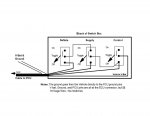CTIS ECUs can have as many as 8 different variants stored in them. Depending on how Pins (Z) and (M) are wired (High, Float, or Ground) The ECU will load the parameters on power up. (Float Float) may be set for a 4x4 and (High, Gnd) may be set for a 6x6 Heavy. There other parameters in these configurations such as Tire pressure tables, inflation time, deflation time, timing for reading the tire pressures, pressure sensor calibrations. If you try and put an FMTV ECU on a 939 it could fault out due to these calibration differences and the ECU CAN circuit will blow because that Pin is grounded on a 939. If you replace an ECU you need to make sure it is compatible with the vehicle. A 2006 ECU can go on a 1998 truck but the truck may not have a connector to hook up the diagnostic software. A 1998 PCU may only deflate to 16 psi, but a 2006 PCU may be able to deflate down to 12 psi. I guess my point is exchanging new and old CTIS parts can be a good thing but can be a bad thing if you don't get it right.


